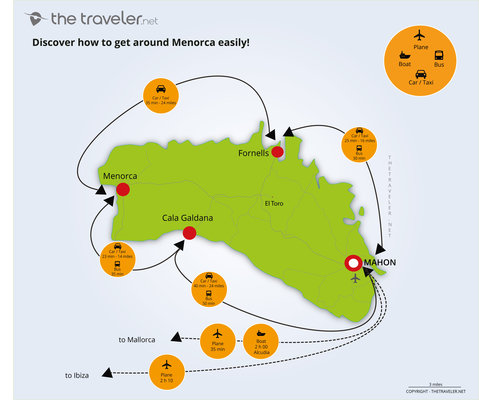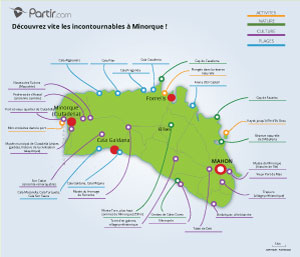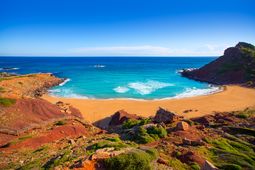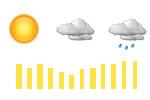Plan an amazing trip to Menorca
Minorca is a little gem waiting to be discovered. Not overly touristic, its natural environment invites exploration. You won’t find a frenetic activity here, where time is taken to make the most of life. Its beaches, placid in the south and untamed in the north are often enough to satisfy visitors. The centuries-old culture is rich and the island harbours many archaeological remains. The cities of Mahon and Ciutadella with their grand architecture and their distinct atmospheres are themselves worth the detour. Minorca is a destination for lovers of nature, lovers of the sea and for lovers in general.
Best time to go to Menorca
Check our complete climate guide to know the ideal season for your next trip. Month by month, you will find the temperatures, sunshine and rainfall history.
What to see and what to do in Menorca
Answers to your most frequently asked questions
The protected natural environment (Minorca is a Unesco Biosphere Reserve)
- Hidden coves and divine beaches,
- Relatively few crowds,
- Millenia of culture to be discovered,
- A way of life which respects the environment.
- Relatively little to do, especially in the evenings,
- Few activities for children other than the beach,
- No road which circles the island.
Yes, especially if you want to explore nature and discover the past with the young ones. The main event, of course, will be the beach. The numerous bays in the south of Minorca are shallow, well patrolled, moderately used and are ideal for families. Es Grau on the east coast is particularly suitable for children. Walking in nature promises endless surprises: you won’t know whether to take in the pines or the infinite blue shades of the sea. Or tramp around ruins to discover how we lived 3,000 years ago. There is a water park near Fornells as well as those within the hotel complexes. Finally, if they like horses, rides are organised by various equestrian schools or why not attend the equestrian show in San Martorellet near Ferreries?
Yes, but it takes time (remember the ‘slow’ way of life?) Hiring a car in Minorca is essential for discovering the island’s treasures. One major road crosses the island from east to west from Mahon to Ciutadella. From that road, minor roads take you to the seaside resorts. There is no road which circles Minorca… at least, not for cars. Horse riders, cyclists and walkers can use the magnificent Cami des Cavalls which loops around the island. Similarly, buses run from Mahon to Ciutadella. In order to reach another town, you have to head back to the main road. And to reach the most beautiful bays, you will nearly always have to complete the journey on foot. Take sturdy shoes. The island isn’t very big and journeys are never very long. Refer to our map of Minorca for the distances between Minorca’s towns.
Absolutely. Minorca is a romantic island. You can fly there directly, but if you have the time, here’s our advice: Fly to Barcelona and spend a day or two in the beautiful Catalan city. Then take the ferry to Alcuida on Majorca - you’ll avoid the crowds in Palma. Then take the ferry to Minorca, arriving in magnificent Ciutadella with its pink and ochre walls. Then make the most of this quiet and protected island (it is a UNESCO nature reserve). From the white beaches in the south to the red sands of the north, you won’t tire of the romantic setting. And if you want to discover more, you have the choice of walking, horse-riding or cycling. Bon voyage!
As in Ibiza, fields of sea grass (posidonia) indicate the remarkable purity of the water. Discover the cliffs and caves close to S’Alcaufar, in the south. The more experienced can dive the wreck of the Santa Clara and one of the islands most famous dive sites, a Junker 88 resting at the bottom of the ocean. Apparently, you can still see the cockpit! In the north, sea life enthusiasts can be enchanted by the marine reserve near Fornells.
There are a number of culinary treats you can take back with you including charcuterie and Minorca’s famous cheese, mao. In Ciutadella, an ancient cloister has been converted into an artisans market. The AOC cheese from Alaior has been made there since the 5th century. The town is also renowned for its luxury shoes. If you want to swaddle your feet at more reasonable prices, try ‘avarcas’ the traditional Minorcan sandal. The famous Xoriguer gin is also distilled in Minorca.
One thing is certain - you’ll eat well. Wine and gastronomic tours are available and farms and, (cheese) dairies can be visited. Queso de Mao has been made in Majorca since the 5 th century. It was in Mahon that mayonnaise was invented. Calderata is a crayfish stew and is well renowned but very expensive. Others, less costly seafood specialities include sépia al forn (roast cuttlefish) and razor clams. For vegetarians, ‘tumbet’ is a local speciality of potatoes, vegetables and tomato sauce. As with all the Balearic Islands, you will find Arabic influences in the local desserts. Namely, ‘torta de merengue (meringue tart), patissets - delicious star-shaped cakes, and coco bamba cake. Following the arrival of the British, Minorca distills its own gin which is mixed with lemonade to make the local aperitif ‘pomada’ or ‘gin omb limonada’.The best known gin is Xoriguer. Good beers and wine are also produced here. Plenty of restaurants subscribe to the ‘slow food’ movement (the opposite of fast food), using local and seasonal ingredients in authentic dishes. See our guide to accommodation in Minorca for ‘slow’ hotels.
Minorca is rich with millennia of history and over 1,600 listed sites. The finest date back to the Talaoitic period, 1,400 years before our era. You will find evidence of ‘Talayots’ everywhere - charming conical megaliths. In Naveta de Tudons you will find another ancient monument in the shape of an upturned hull. In Le Trepuco (near Mahon) you can still visit the ‘taula’ an enclosure of talayots and the remnants of ancient dwellings. Talati de Dalt is another very well known and well-conserved site near Mahon. For more information, check out our map of the essential Minorca
It’s certainly not Ibiza, but you will be able to chill out here. Ciutadella is very lively with its markets during the day and numerous bars and restaurants in the port. Compared with Mahon which is more anglicised and calmer, Ciutadella is typically Spanish with something of Barcelona’s atmosphere of long evenings.
Beyond Ciutadella, there are few clubs, with the exception of Cova d’En Xoroix, a nightclub in a cave! With its exceptional position and flanked by two cliffs, the club offers
plunging views of the sea below. During the day it is a bar and the prices reflect the spectacular setting. Finally, although the island is replete with beach bars (‘chiringuitas’) during the day, parties on the beach are prohibited at night in Minorca.
Everything depends on your tastes. There are over 70 beaches of striking contrasts in Minorca. In the south, around Cala Galdana (one of the few paved beaches on the island), there are some wonderful bays. Cala Mitjana, Cala Macaella and Cala Turqueta, among others , are superb beaches with white sand and clear, warm water. They have the advantage of being very accessible. To the north, between Ciutadella and Fornells, the countryside changes. Immense beaches (Cala Pilar, Cala Pregonda) where ochre sands contrast with the turquoise sea possess a wild, windswept beauty, all the more appreciable for having to walk for an hour in order to swim there. This can be an advantage as these beaches are not as well frequented. Find Minorca's most beautiful beaches here .


















